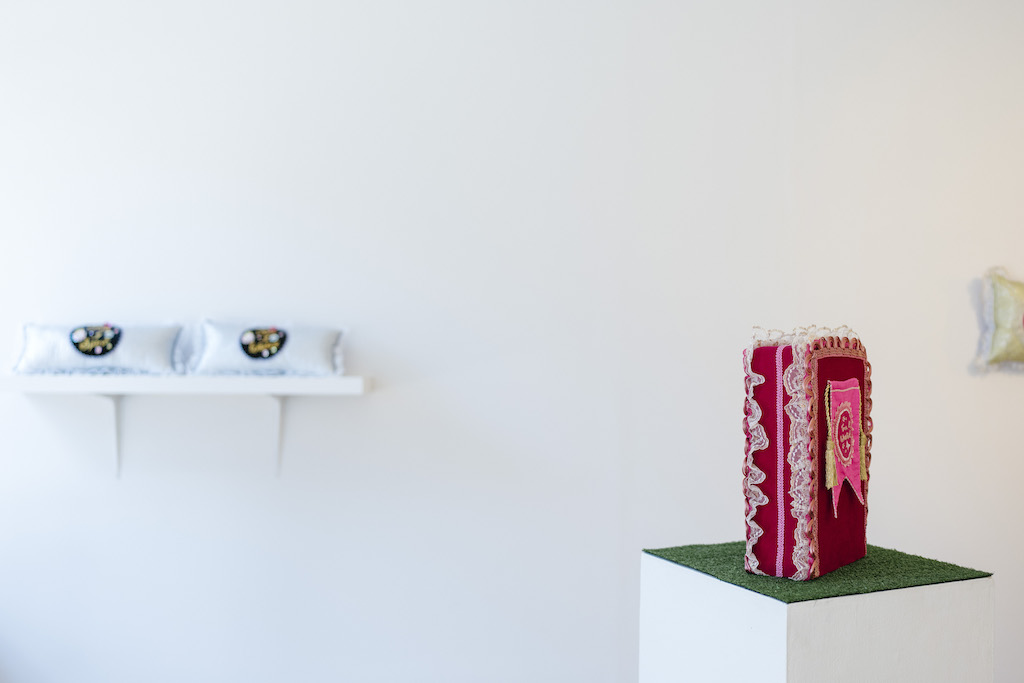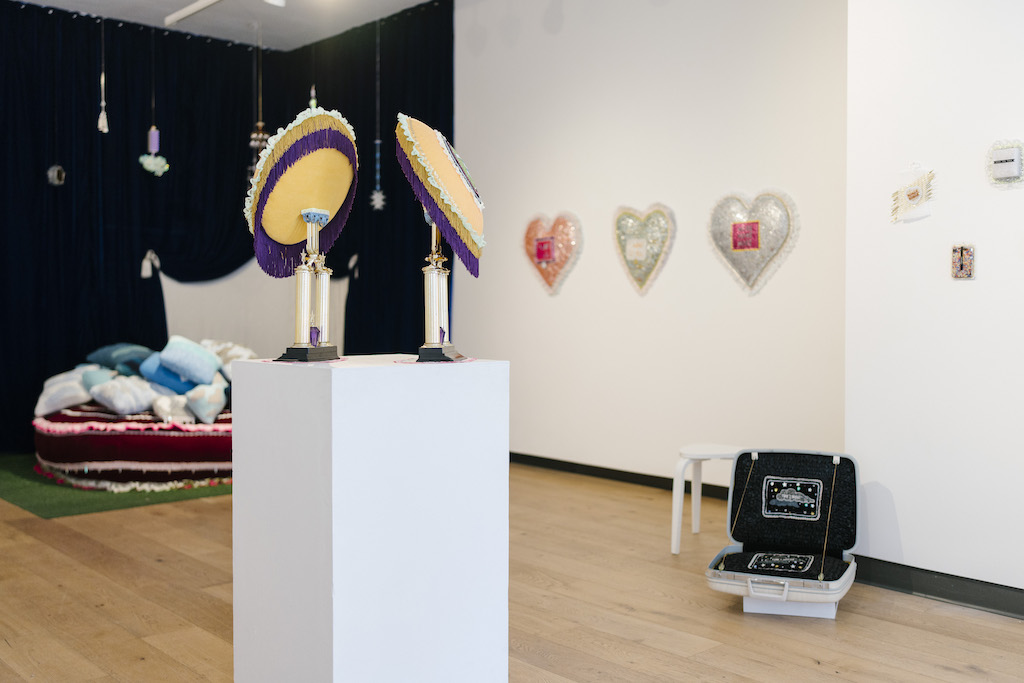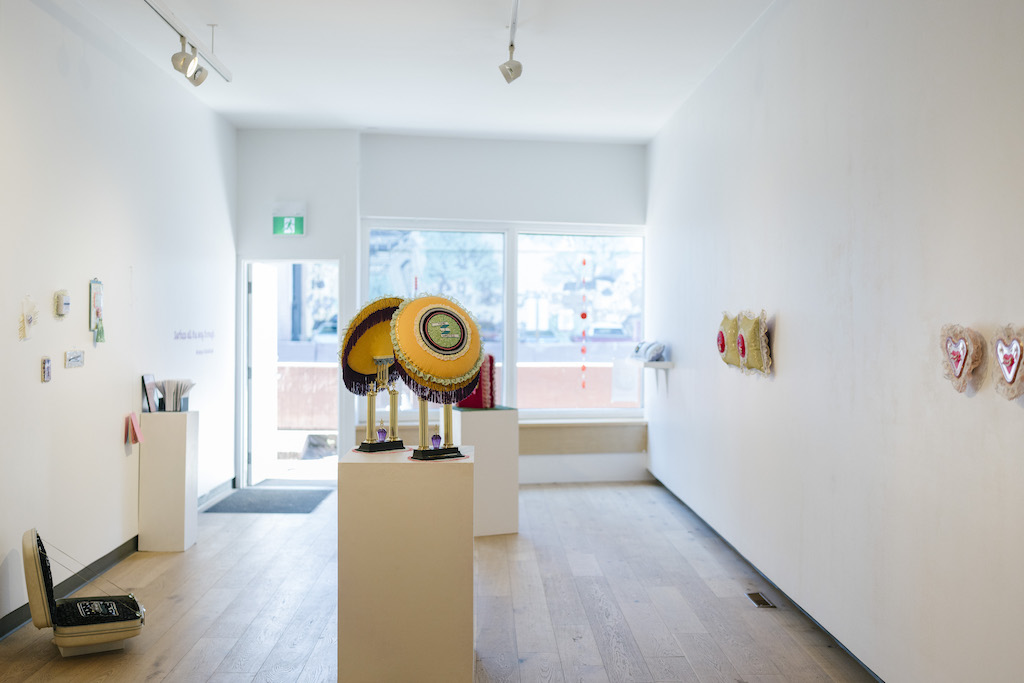Surface all the way through is a collection of sculptures made from discarded materials that look like pillows. Abandoned craft supplies collected from the thrift store have been copiously layered to form decorative surfaces that conceal interiors of plastic packaging trash. While making this work with my sewing machine and vintage knitting machine, I was ruminating on waste, superficiality, sentimental materialism, distraction, accumulation, and containment.
Pillows, at first an obsession, became a metaphor for all the ways I have tried to compartmentalize and process difficult events or emotions in my life. They are absurdist facsimiles of familiar domestic objects meant to provide ornamental distraction and comfort, a place to carry and hold all that I don’t want to, a fantasy vision of a place to land.
This exhibition is composed entirely of plastic in its many forms: a material that I am endlessly attracted to for its shape-shifting mimicry and limitless supply of exciting surface qualities. As a toxic, uncontainable, and grossly over-produced material, it is also repulsive and surrounds me with dread and despair. As a foil to these crushing emotions, there is whimsy, humour, and a sincere appreciation of kitschy camp aesthetics in these handcrafted soft-sculptures.
︎Fascination Station
In coincidence with “Surface all the way through” a satellite exhibition titled “Fascination Station” will be exhibiting at the CADA Open Spaces Window at the Centre Street C-Train Station.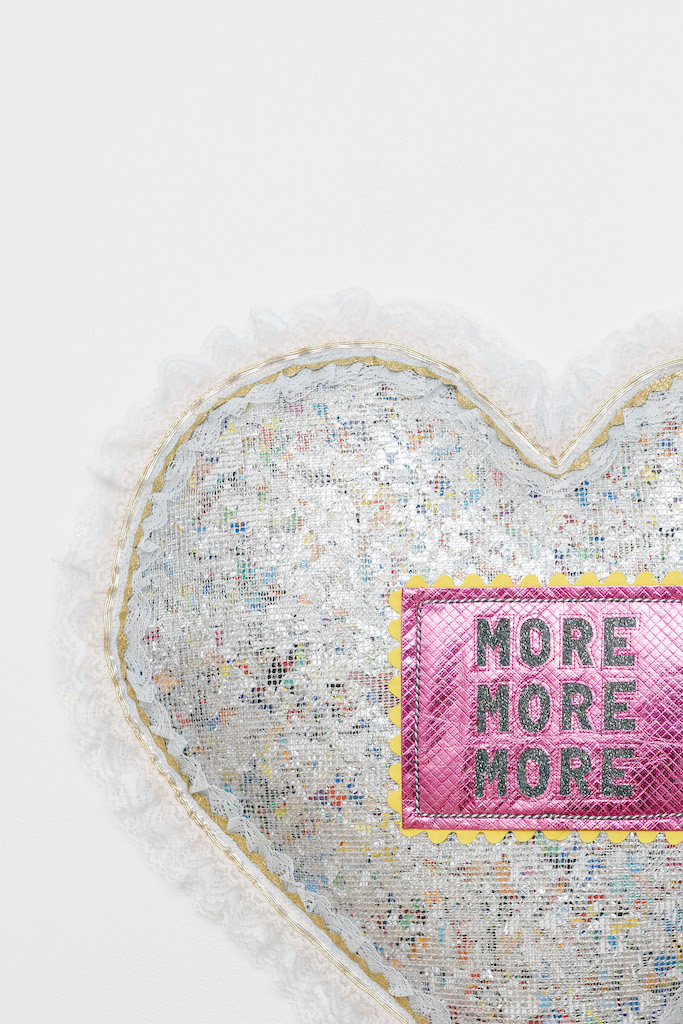





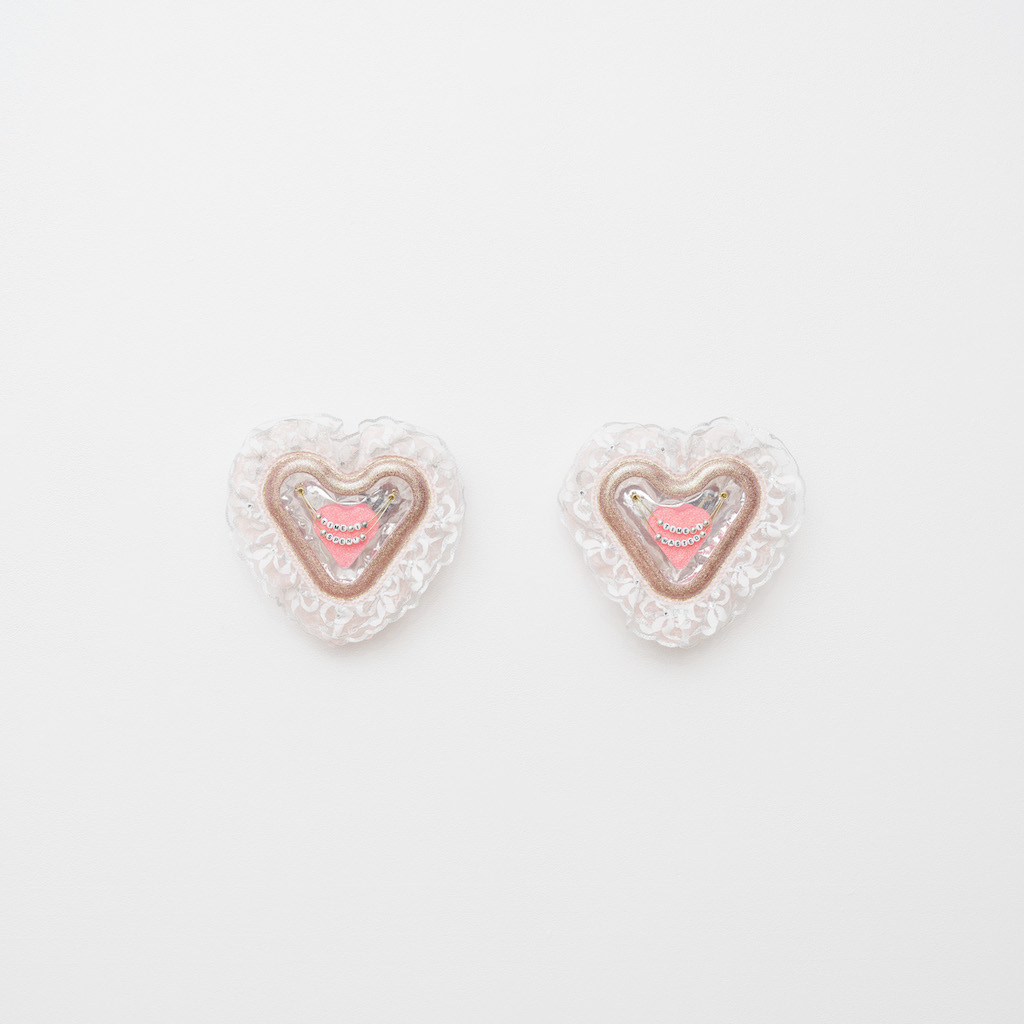
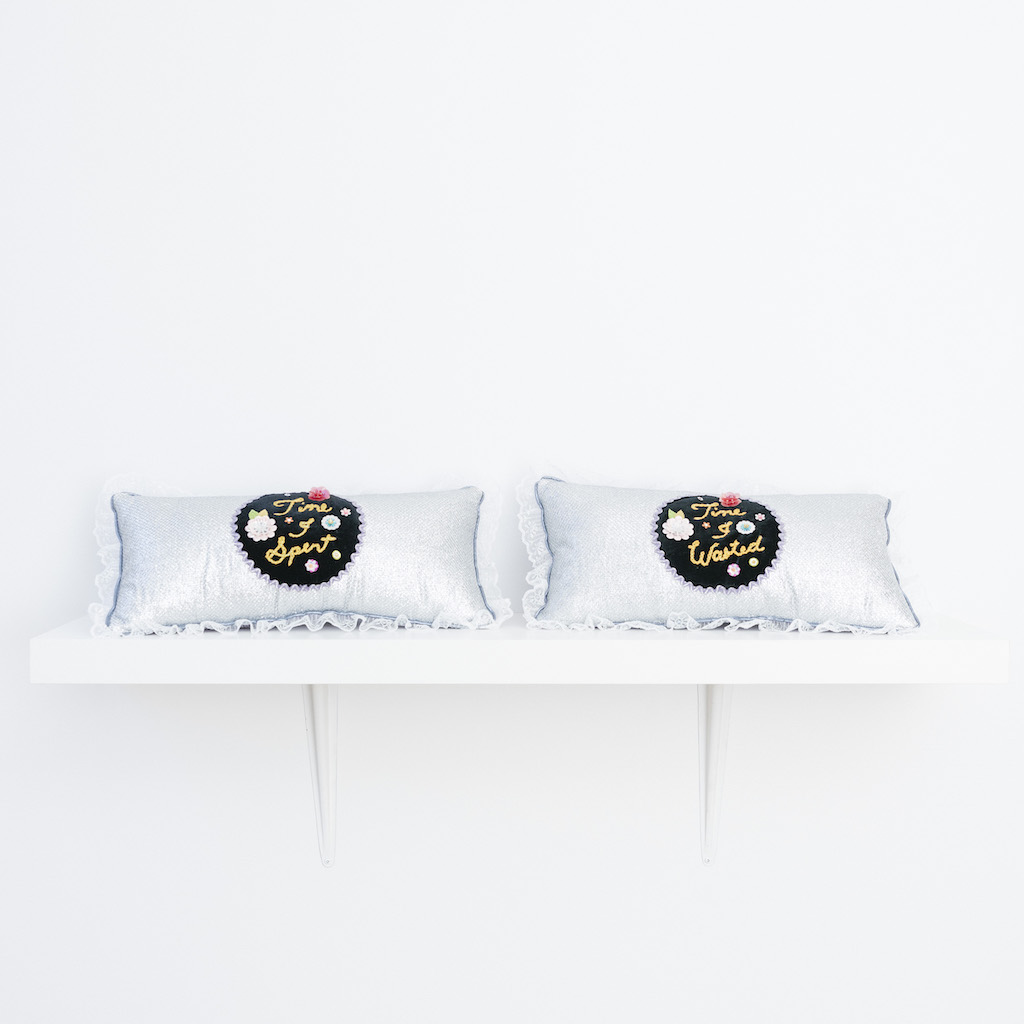


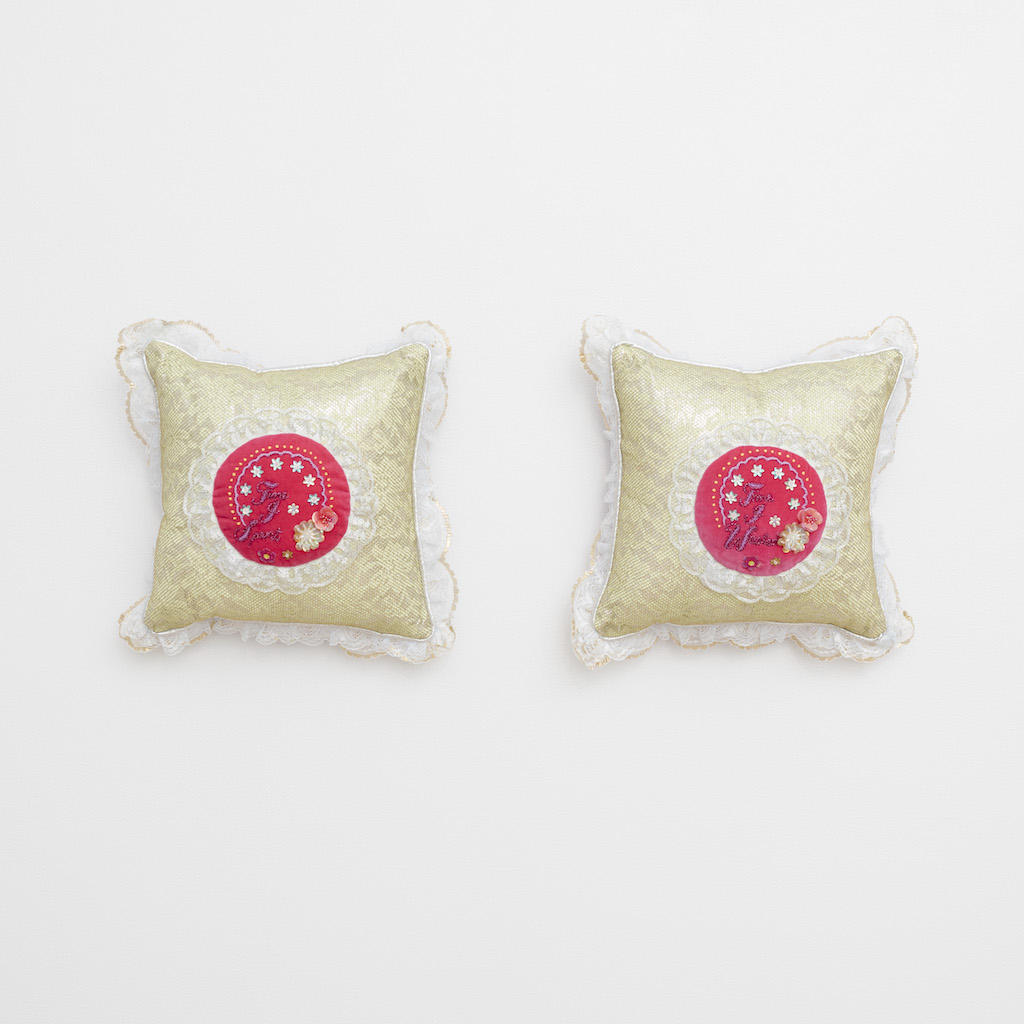

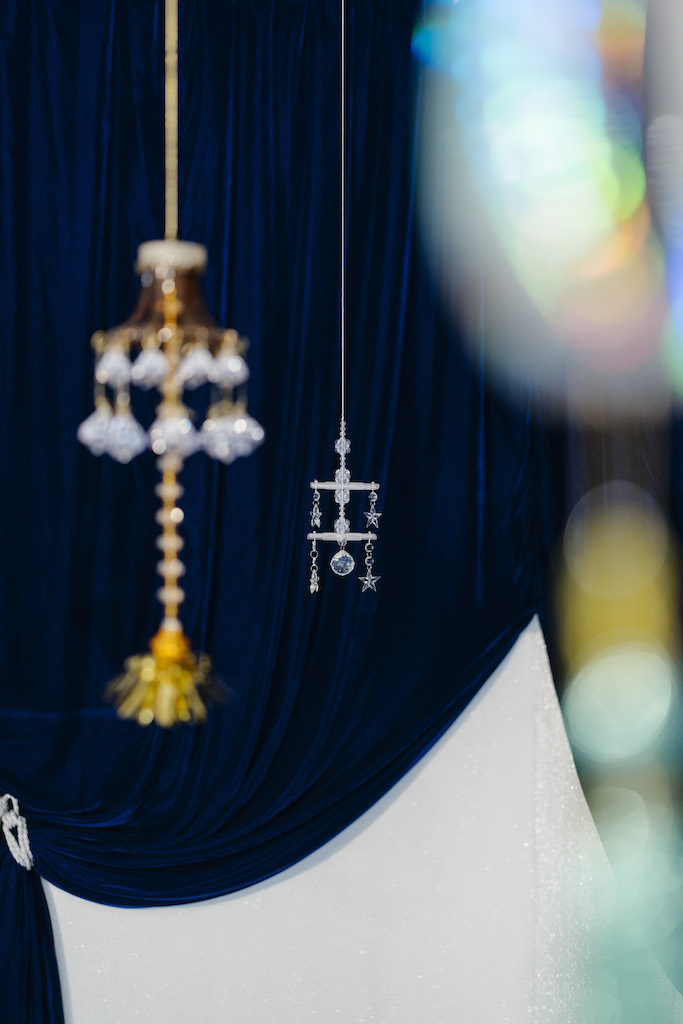







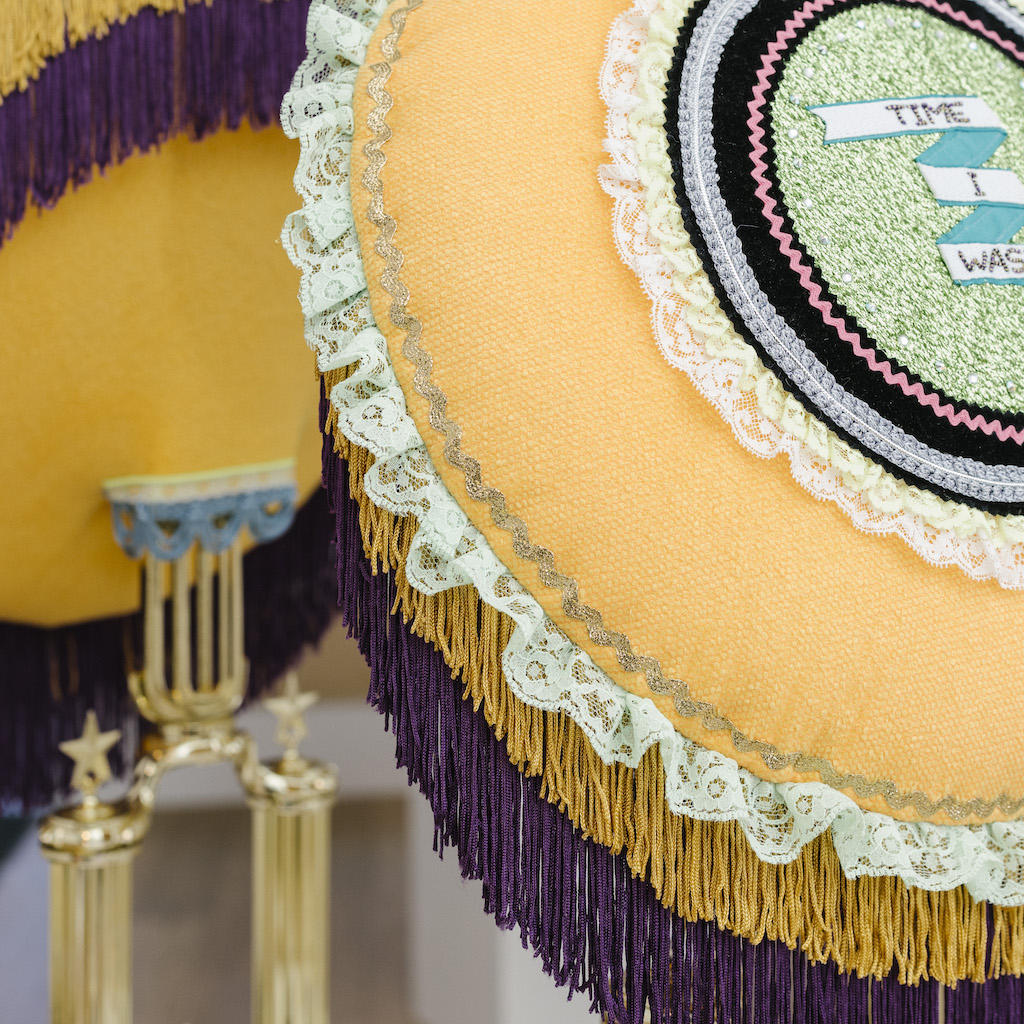




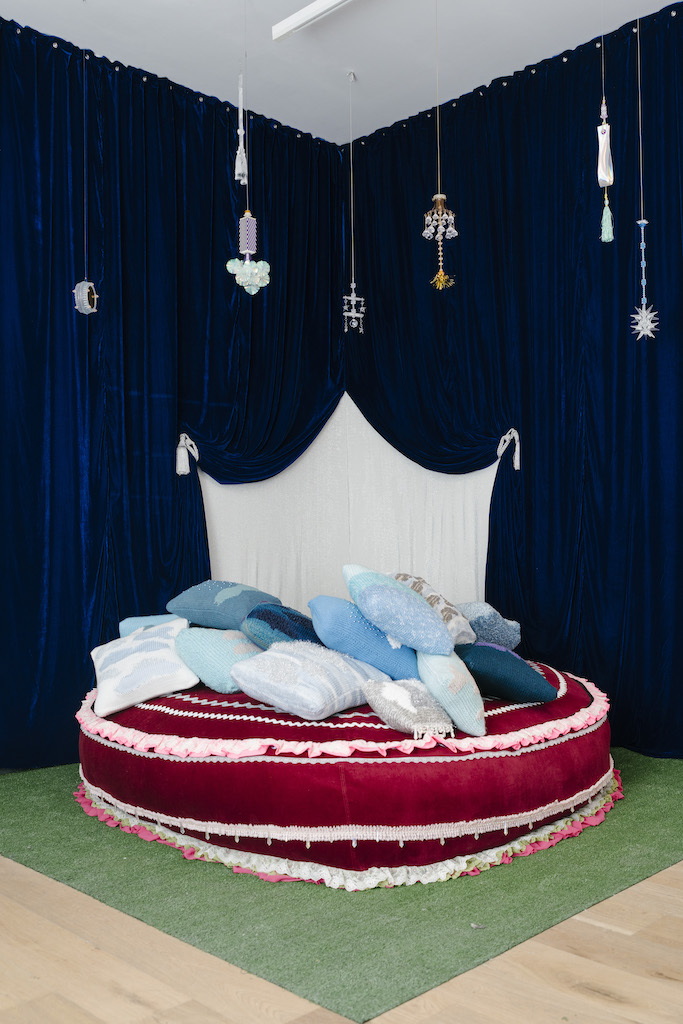



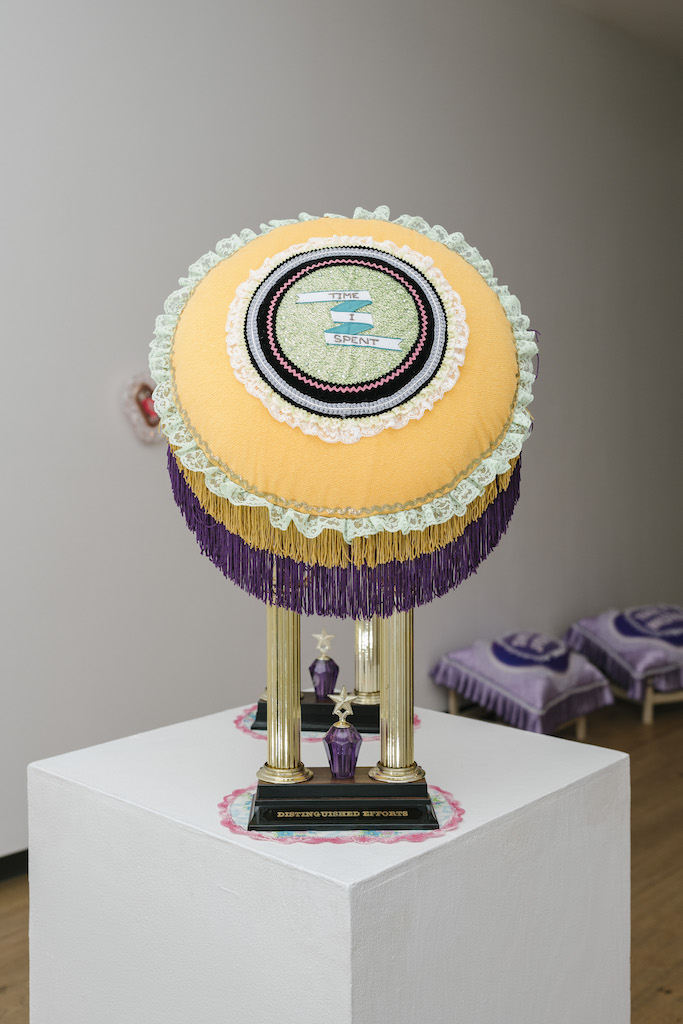





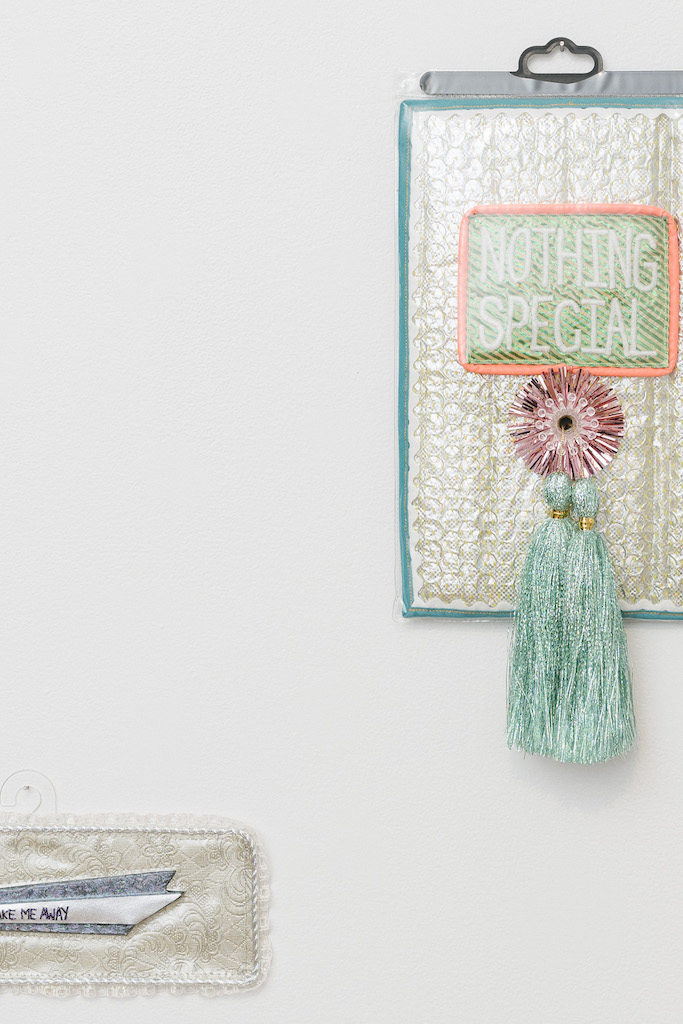
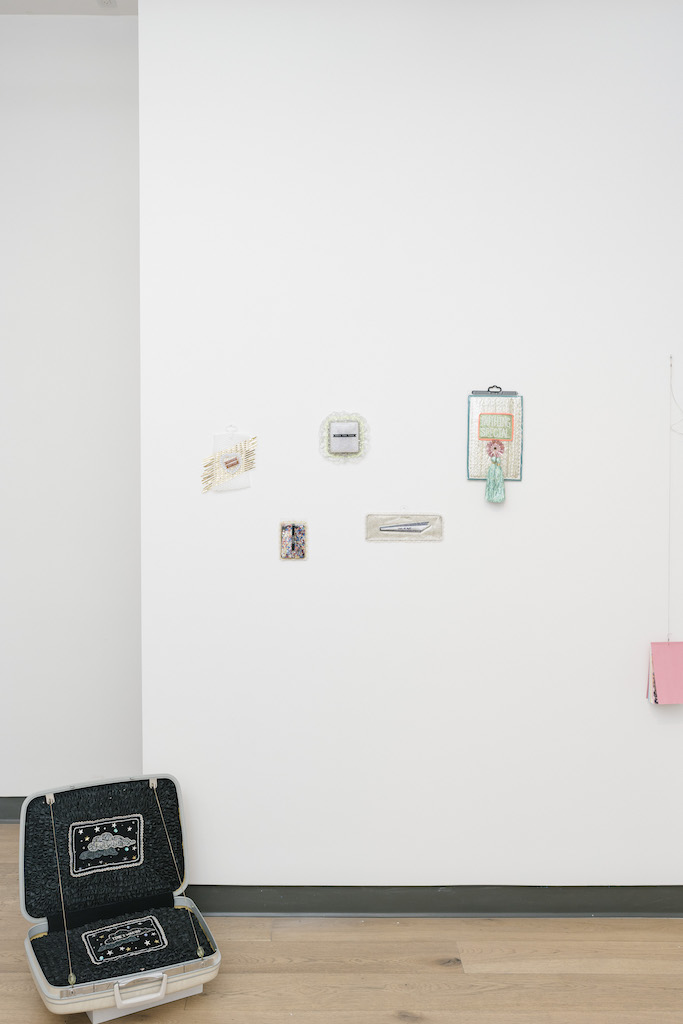
Documentation by Danny Luong.
Plastic Entanglements
Morgan Martino
Kitsch & Aesthetics of Consumption
In Surface all the way through, Arianna Richardson plays with and heightens the forms and stylings of mass-produced kitsch objects in her one-of-a-kind sculptures, encouraging us to confront our multifaceted relationships with plastic goods. Across the gallery are several sculptures within a series (Time I Spent & Time I Wasted, 2022-Ongoing), each emblazoned with the phrases “Time I spent” and “Time I wasted”. The openness of these statements combined with the specificity of the objects they are a part of (from pillows to suitcases to trophy bases) brings into focus the contradictions at the heart of this work. What is the value we ascribe to the materials, labour, and time necessary for this artwork to exist? How might we reconcile the effort expended to create these objects of beauty out of disposable and mundane artifacts, especially in today's fast-paced, product-focused, and consumer-centric landscape?
The opulence and excessive adornment of these sculptures evokes a nostalgia for the knick-knacks and trinkets we might find cluttering the homes of relatives or along the aisles of gift shops and thrift stores. Through their kitsch aesthetics and accessible forms, these works allow for genuine sentiment from the viewer. In making us smile or laugh, they help to draw us into reflecting on our own patterns of (over)consumption of plastic objects, which are at once disposable and impossible to rid ourselves of. While working with cheap, found, and re-used plastic materials, the artist displays an immense level of craft, with each piece of beading and ricrac carefully attached to one another using various handicraft methods. The time and effort on display makes us question the ways in which we value these abundant, everyday plastic artifacts. How should we feel about this wonder-material which can take on so many different shapes, properties, and uses at the expense of our biosphere?
Jellyfish & Plastic Monsters
Richardson further complicates our relations with and responsibilities to plastic in her sculptural series. Within the Fascination Station (2022-Ongoing), several dozen sculptures float in super-technicolour splendour above the gallery space*. Together they evoke a forest of sea creatures, bioluminescing with each other and their surroundings. Each ‘fascinator’ is unique in style and form, with different found plastic materials skillfully arranged to compose its body. Close inspection reveals red reflective driveway markers, orange traffic cones, fluorescent pink produce netting, and mardi-gras party beads among their construction. The shapes and movements of these artifacts remind me most of jellyfish. In Arts of Living on a Damaged Planet: Ghosts and Monsters of the Anthropocene, Anna Tsing, Nils Bubandt, Elaine Gan and Heather Anne Swanson use jellyfish as an example of a species who has become monstrous through their entanglement with humans. Tsing et. al. argue that because humans have created the conditions for jellyfish to flourish and invade new ecosystems (through overfishing practices, pollution, and climate change), we have inextricably entangled ourselves with them.
Plastic shares similar entanglement with us—our over-production and over-consumption of plastic over the past 118 years** has contributed to the wicked problems of climate change, environmental degradation, and the overall health of our planet. Richardson’s Fascinators help us to consider our own monstrous relations to plastic—their beauty attracting and horrifying us at the same time. The artist asks us to more closely consider how the allure of bright, cheap, and abundant plastic goods dazzles and blinds us to their inevitable afterlife in landfills and ocean garbage patches.
Handicraft & Acts of Care
While we may experience feelings of despair and hopelessness when confronting the tonnes of plastic waste we consume as individuals and produce as a species, Richardson is able to use her artistic practice to help us imagine other ways of co-existing with this horrifically beautiful material.
On the floor are the largest works of the exhibit. Visitors are invited to sit or lie on For Every Feeling Ever Felt (2023), which straddles the line between sculpture and furniture. The saccharine sweetness of its bright, heart-shaped form welcomes the touch and weight of our bodies, offering a moment of rest within the gallery space. The pillows piled on top of For Every Feeling I Ever Felt (machine knit using thrift-store yarn and beads) provide even more sensory enjoyment and interactive possibilities, allowing us to keep our head in the clouds, literally. For me, these works best embody the care that permeates Richardson’s practice as an artist. Through carefully cleaning, arranging, and re-purposing soft plastic waste and discarded objects from the artist's personal and professional life to fill the bodies of these sculptures, she demonstrates a deep empathy for both the materials she is working with and for the viewers of her work.
In his essay “Love your Monsters: Why We Must Care for Our Technologies As We Do Our Children”, philosopher Bruno Latour advocates for our continued nurturing of the objects and technologies we create, regardless of how monstrous we come to see them, arguing that “…our sin is not that we created technologies but that we failed to love and care for them. It is as if we decided that we were unable to follow through with the education of our children”. In Surface all the way through, Richardson cares for the plastic tassels, tinsel, and trinkets which would otherwise become unloved detritus and, through her dedicated handicraft, deepens her relationship with them rather than shying away from the discomfort they may cause. From this exhibit I am left to consider how I might resist attempts at emancipating myself from the plastic waste found in my own life, and the ways in which I can better care for and relate to it.
Bibliography:
Tsing, Anna Lowenhaupt, ed. 2017. Arts of Living on a Damaged Planet. University of Minnesota Press.
Latour, Bruno. 2012. “Love Your Monsters.” The Breakthrough Institute, February 14. https://thebreakthrough.org/journal/issue-2/love-your-monsters.
**The first synthetic plastic, Bakelite, was first developed in 1907.
Arianna Richardson is a sculptor, performance artist, sewist, and mother from Lethbridge, AB in Treaty 7 territory. She is a lifelong crafter and thrift-store enthusiast, constantly collecting plastic-based trash and discarded craft materials. Richardson sometimes performs under the pseudonym, The Hobbyist, taking her hobby-craft pursuits outdoors to activate public spaces and talk to people about trash. While she isn’t making art, Arianna works as Lead Prepator at the Southern Alberta Art Gallery and as a sessional instructor teaching Spatial Practice at the University of Lethbridge.
Richardson holds a BFA (2013) in Studio Arts from the University of Lethbridge and an MFA (2018) from NSCAD in Halifax, NS. Her first artist book, Garbage Party: A Collection of Thoughts About Trash, was self-released in March 2021.
Morgan Martino is an interdisciplinary designer, artist, researcher, and educator living on the unceded territories of the Musqueam, Squamish, and Tsleil-waututh. Her current research practice explores the ways in which everyday objects, interactions, and collections can be understood as sites for engaging with wicked problems of overconsumption, climate change, and gender inequity through community- and place-based engagements. She holds a Masters of Design and Bachelor of Design from Emily Carr University of Art + Design, where she currently works as a sessional instructor.
表里如一
Arianna Richardson
2025年10月24日至12月13日
Arianna Richardson
2025年10月24日至12月13日
表里如一是一組由廢棄材料制成、外觀如靠枕般的雕塑作品集。從舊貨店收集的廢棄手工藝用品被大量疊加,形成裝飾性的表面,掩蓋著內部的塑料包裝垃圾。在用縫紉機和老式編織機制作這些作品時,我一直在思考浪費、膚淺、感傷的物質主義、分心、積累和容納等議題。
靠枕最初只是我的一種執念,後來卻成了一個隱喻,象征著我如何嘗試將生命中那些艱難的事件與情緒分門別類、加以整理與消化。它們是熟悉的家居物品的荒誕仿制品,旨在提供裝飾性的消遣和慰藉, 一個可以承載與包容我不願面對之物的所在,一種關于“落腳之處”的幻想性願景。
本次展覽的所有作品皆由各種形式的塑料構成。這種材料令我著迷,它可塑性極強、具備無盡的仿擬能力與令人興奮的表面質感。然而,作爲一種有毒、難以控制且被過度生産的物質,塑料也令人厭惡,讓我感到恐懼與絕望。面對這些壓抑的情緒,我以異想天開的幽默感和對俗豔美學的真誠欣賞來作爲反襯,在這些手工縫制的軟雕塑中尋找輕盈與釋然。
塑料糾葛
Morgan Martino
俗豔與消費美學
Morgan Martino
俗豔與消費美學
在表里如一中,Arianna Richardson在她獨一無二的雕塑作品中探索並強化了大批量生産的俗豔物品的形式和風格,促使我們直面與塑料制品之間多面向的關系。整個畫廊中展示了系列作品(Time I Spent & Time I Wasted, 2022–至今)中的幾件雕塑,每件作品都印有"我度過的時間"和"我浪費的時間"的字樣。這些陳述的開放性,結合它們所屬物品的特殊性(從靠枕到手提箱再到獎杯底座), 凸顯了作品核心的矛盾。我們賦予這些藝術品存在所需的材料、勞動和時間哪些價值? 在當今節奏迅速、以産品爲中心、消費至上的社會環境中,我們該如何調和這種花費大量精力,以一次性與日常廢棄物爲基礎的創造出這些充滿美感的作品所帶來的矛盾感?
這些雕塑的華麗和過度裝飾喚起了我們對親戚家中雜亂擺放的小擺設和小飾品,或禮品店和舊貨店過道上物品的懷舊情懷。通過俗豔美學和易于理解的形式,這些作品讓觀衆産生真實的情感。當它們令我們微微一笑或開懷大笑時,也促使我們反思自己對于塑料制品的(過度)消費模式, 這些物品既是一次性的, 又難以擺脫。在使用廉價、拾得和再利用的塑料材料時,藝術家展示了精湛的工藝水平,每顆珠子和每條花邊都使用各種手工藝方法精心連接在一起。展現出的時間和努力使我們不得不反思:我們究竟是如何看待這些隨處可見、日常而平凡的塑料制品的?面對這種能夠呈現出無數形態、性質與用途,卻以犧牲生物圈爲代價的神奇材料,我們應當抱持怎樣的情感?
水母與塑料怪物
Richardson在她的雕塑系列中進一步深化了我們與塑料之間的關系及其所隱含的責任。在Fascination Station(魅惑站,2022–至今)系列中,數十件雕塑以絢爛的色彩與奇幻的光澤漂浮于展覽空間之上。它們共同構成一片仿若海洋生物的森林,彼此之間及與周圍環境一同閃耀著生物熒光。每一個吊飾在造型與風格上都獨一無二,由藝術家將不同來源的拾得塑料材料巧妙地組合與排列而成。近距離觀察時,我們可以辨認出紅色反光車道標、橙色交通錐、熒光粉色的水果網袋,以及狂歡節串珠等元素。它們的形態與流動感最令人聯想到水母。在Arts of Living on a Damaged Planet: Ghosts and Monsters of the Anthropocene一書中(《在受損的星球上生存的藝術:人類世的幽靈與怪物》), Anna Tsing、Nils Bubandt, Elaine Gan與Heather Anne Swanson將水母視爲一種因與人類的糾纏而變得怪異的物種。作者們指出,人類通過過度捕撈、汙染與氣候變化,創造了使水母得以繁盛並入侵新生態系統的條件,因此我們已與它們不可分割地糾纏在一起。
塑料與我們之間也存在著類似的糾纏,在人類過去118年間對塑料的過度生産與消費,已直接促成了氣候變化、環境惡化及地球整體健康的嚴峻問題。Richardson的吊飾系列讓我們思考自身與塑料之間怪異的關系, 它們的魅力在吸引我們的同時,也讓人感到不安。藝術家邀請我們更深入地思考:那些色彩鮮豔、廉價且泛濫的塑料制品,其耀眼的魅力如何迷惑了我們,讓我們忽略它們終將在垃圾填埋場與海洋廢墟中繼續存在的命運。
手工藝與關懷行爲
當我們直面自己作爲個體所消耗和作爲物種所制造的成噸塑料垃圾時,往往會感到絕望與無力,但Richardson能夠運用她的藝術實踐幫助我們想象與這種可怕而絢麗的材料共存的其他方式。
畫廊地面上陳列著本次展覽中最大的作品。觀衆受邀坐上或躺在For Every Feeling Ever Felt, 2023上,一件介于雕塑與家具之間的作品。其明亮、心形的外觀帶著甜膩的溫柔,邀請我們去觸碰與倚靠,在展覽空間中提供片刻的休憩。堆疊在這件作品(For Every Feeling I Ever Felt)之上的靠墊,是以二手商店的毛線與珠子機織而成,爲作品增添了更多的感官愉悅與互動的可能,讓我們得以真正地把頭埋進云端。在我看來,這些作品最能體現Richardson作爲藝術家所貫穿始終的那份關懷。她細致地清潔、整理,並重新利用自己生活與工作中産生的柔軟塑料廢料與被棄物,將它們填充進這些雕塑里。通過這一過程,她不僅對材料懷有體貼的共情,也將這種情感傳遞給觀看作品的人。
在哲學家Bruno Latour的論文Love your Monsters: Why We Must Care for Our Technologies As We Do Our Children(愛你的怪物:爲何我們必須像對待孩子一樣去關懷我們的技術)中,他主張人類應持續培育自己所創造的物件與技術,無論我們後來如何視它們爲“怪物”。他指出:“我們的罪,並非在于創造了技術,而在于未能去愛與照料它們, 就好像我們決定不再承擔教育自己孩子的責任。”在展覽表里如一中,Richardson悉心呵護那些原本注定被遺棄的塑料流蘇,亮片與裝飾碎片。通過她專注的手工勞動,她選擇深化與這些材料的關系,而不是回避它們可能帶來的不適。從這個展覽中,我開始思考在自己的生活中,我是否也能抵抗那種急于“擺脫”塑料廢棄物的沖動?又該如何以更有同理與關懷的方式,與這些材料共處?
參考文獻
Tsing, Anna Lowenhaupt(主編),2017年, Arts of Living on a Damaged Planet (《在受損的星球上生存的藝術》),明尼蘇達大學出版社。
Latour, Bruno,2012年,Love Your Monsters (《愛你的怪物》)。發表于 The Breakthrough Institute,2月14日。https://thebreakthrough.org/journal/issue-2/love-your-monsters
*Fascination Station(魅惑站)亦將于2025年11月9日至12月7日期間,在位于 中央街輕軌站平台的 CADA Open Spaces 畫廊舉辦衛星展出。本次延伸展覽(由 新畫廊、CADA 與 STEPS Public Art 支持)將包含由公衆在 TNG 舉辦的工作坊中共同創作的吊飾作品。藝術家希望觀衆能夠親身體驗這些創作所需的勞動,並以藝術的方式與這些材料互動。
**第一種合成塑料酚醛樹脂于1907年首次開發。
Arianna Richardson是一位來自加拿大亞伯達省第七號條約領地萊斯布里奇市的雕塑家、行爲藝術家、縫紉師以及母親。她自幼熱愛手工藝,並鍾情于舊貨店,經常收集以塑料爲主的廢棄物和被丟棄的手工藝材料。Richardson有時以“The Hobbyist”(業余愛好者)的化名進行表演,將她的業余手工藝追求帶到戶外,以激活公共空間並與人們討論垃圾問題。在不創作藝術的時候, 她在南艾伯塔藝術畫廊擔任布展主管, 同時在萊斯布里奇大學擔任兼職講師,教授空間實踐課程。
Richardson于2013年獲得萊斯布里奇大學藝術創作專業學士學位, 並于2018年在哈利法克斯的NSCAD大學取得藝術碩士學位。她的第一本藝術家書籍Garbage Party: A Collection of Thoughts About Trash(《垃圾派對:關于廢棄物的一些思考》)于2021年3月自行出版。
Morgan Martino 是一位跨學科設計師、藝術家、研究者和教育工作者,居住在Musqueam、Squamish和Tsleil-waututh未割讓的領土上。她目前的研究實踐探索日常物品、互動和收藏如何被理解爲通過社區和地方性參與來應對過度消費、氣候變化和性別不平等等棘手問題的場所。她獲得Emily Carr藝術與設計大學的設計碩士和設計學士學位,目前在該校擔任兼職講師。


